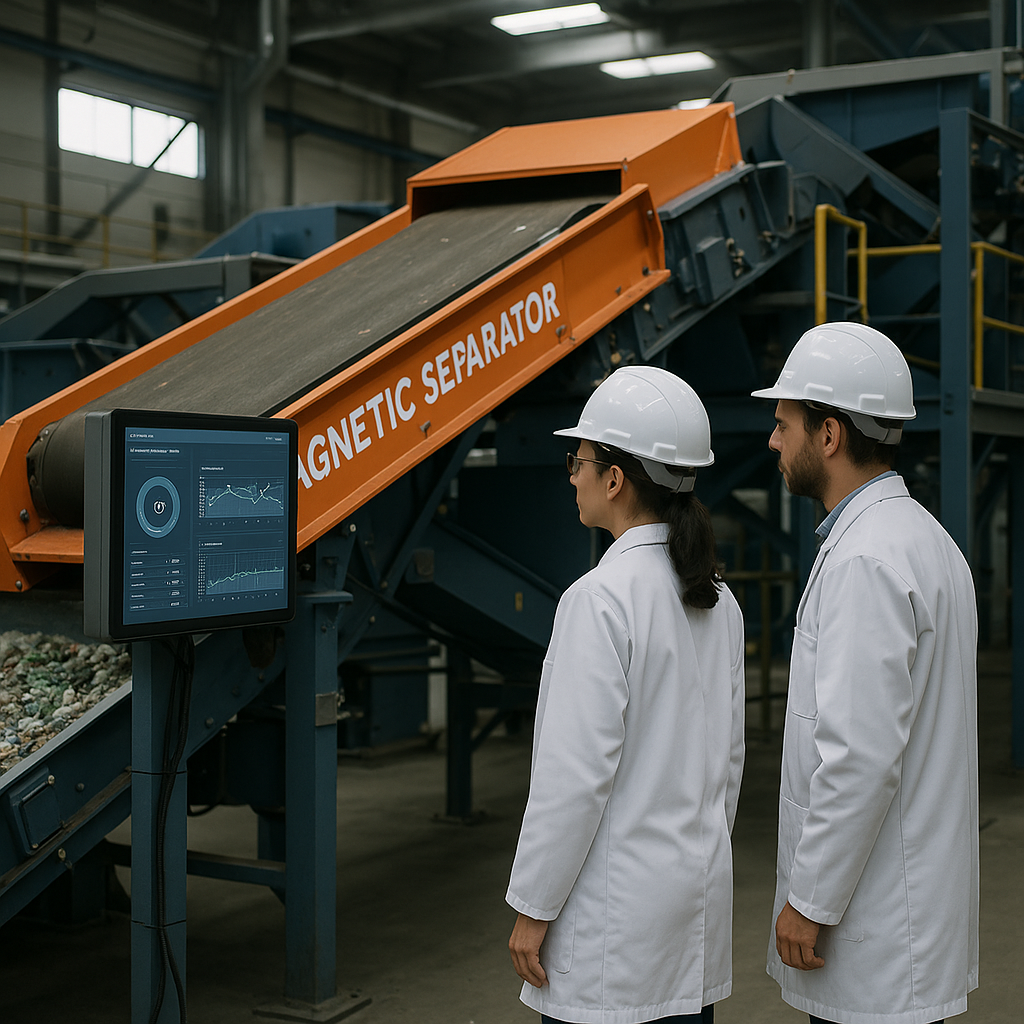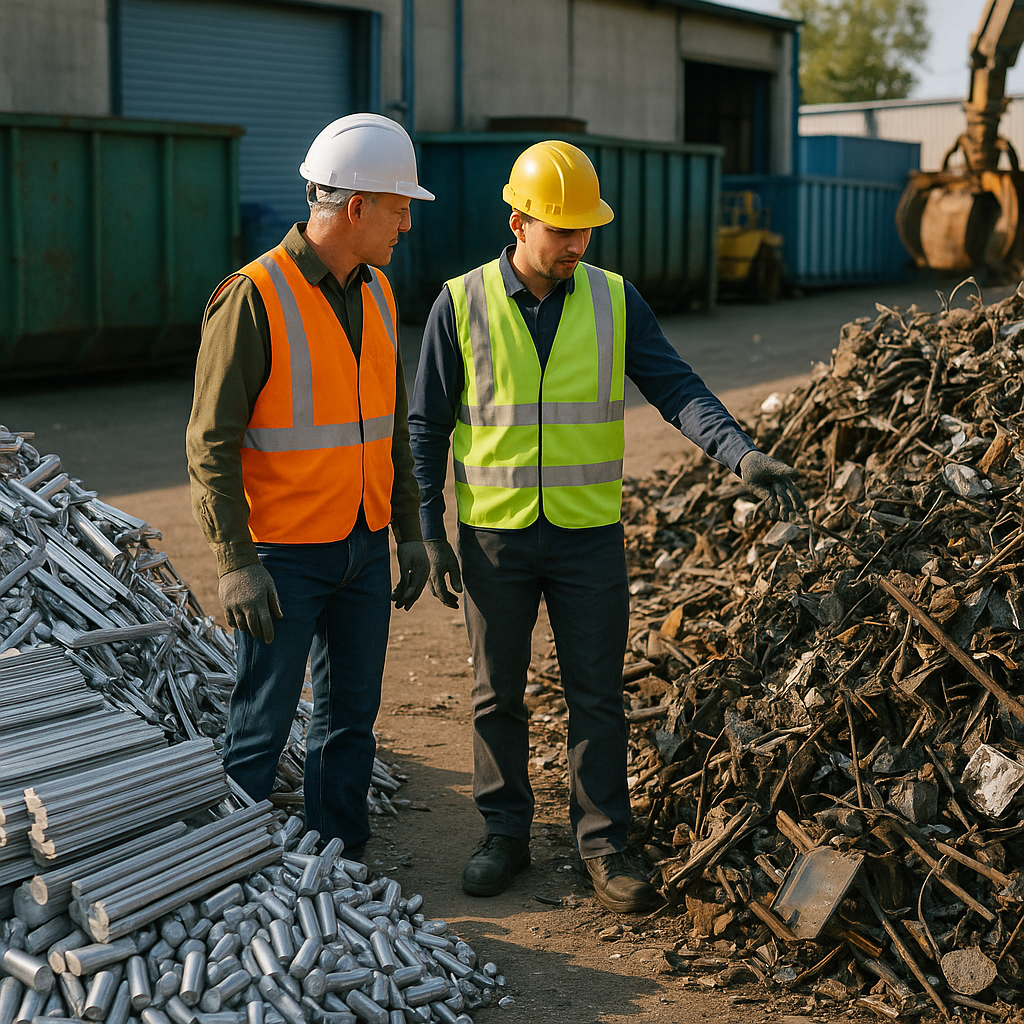5901 Botham Jean Blvd, Dallas, TX 75215
Mechanical Separation of Metals: Techniques, Advantages, and Recycling Applications
October 5, 2025Efficient metal recycling relies on precise separation processes to recover valuable materials from complex waste streams. Mechanical separation is central to this effort, utilizing physical properties—such as magnetism, density, and particle size—to sort metals without chemical or thermal treatment.
These techniques enable recyclers to efficiently process large quantities of scrap, minimizing waste and maximizing resource recovery. From powerful magnetic systems to advanced air classifiers, mechanical separation methods are foundational to modern metal recycling operations, ensuring every recoverable metal fragment is returned to productive use.
Types of Mechanical Separation Techniques in Metal Recycling

Mechanical separation techniques are crucial physical methods in metal recycling, sorting and recovering valuable materials from mixed waste streams. Unlike chemical or thermal processes, these methods rely on the physical properties of metals for efficient separation. Here are the primary mechanical separation methods used in modern recycling operations.
Magnetic Separation
Magnetic separation is a fundamental technique used to recover ferrous metals from mixed metal streams. This method uses powerful magnets mounted on conveyor belts to attract and separate iron, steel, and other magnetic materials from non-magnetic waste.
The process is highly efficient, with separation rates reaching up to 99% for ferrous materials. Magnetic separation equipment ranges from simple suspended magnets to sophisticated drum separators that can continuously process large volumes of material. This technique is particularly valuable in the early stages of metal recycling to quickly remove ferrous components.
Eddy Current Separation
While magnetic separation efficiently handles ferrous metals, eddy current separators target non-ferrous metals like aluminum, copper, and brass. These systems use a rapidly rotating magnetic rotor to create a changing magnetic field, inducing eddy currents in non-ferrous metals.
These induced currents generate their own magnetic field that opposes the original field, causing non-ferrous metals to be repelled from the waste stream. This repulsive force effectively pushes aluminum, copper, and other conductive non-ferrous metals away from non-metallic materials, allowing for clean separation. This technology is crucial for recovering valuable non-ferrous metals that conventional magnetic separators would miss.
Screening and Sieving
Screening is a straightforward yet essential technique that sorts materials based on particle size. Using vibrating screens with different mesh sizes, metals can be classified into various fractions, optimizing downstream processing. The screening process typically involves multiple stages:
- Initial screening to remove oversized materials
- Secondary screening to separate medium-sized particles
- Fine screening to capture smaller metal fragments
This size-based separation is particularly important before other mechanical processes, as it prevents oversized materials from damaging equipment and improves the efficiency of subsequent separation techniques. Modern screening systems can handle high throughput while precisely classifying particle sizes.
Density-Based Separation
Density-based separation methods exploit differences in the specific gravity of materials to achieve effective sorting. Air classification is a common density separation technique using controlled airflow to separate lighter materials from heavier ones.
In an air classifier, materials enter an air stream where lighter particles are carried upward while heavier metals fall. The separation point can be adjusted to target specific materials based on their density. Another density-based method is the gravity separator (also called a specific gravity separator), allowing highly sensitive separations based on density, size, or shape differences.
These systems are particularly valuable for separating metals with similar appearances but different densities, such as distinguishing aluminum from heavier copper or brass components.
| Technique | Description | Examples |
|---|---|---|
| Magnetic Separation | Uses magnets to separate ferrous metals from non-ferrous metals by attracting iron and steel components. | Suspended magnets, drum separators |
| Eddy Current Separation | Repels non-ferrous metals like aluminum and copper using a rapidly rotating magnetic field to create eddy currents. | Aluminum cans, copper wires |
| Screening and Sieving | Sorts materials based on particle size using vibrating screens or mesh sieves. | Initial, secondary, fine screening stages |
| Density-Based Separation | Separates materials based on specific gravity differences using controlled airflow or gravity tables. | Air classifiers, gravity separators |
Combined Separation Systems
In modern recycling facilities, these separation techniques rarely operate in isolation. Instead, they work together in carefully designed processing lines where materials move through multiple separation stages. For instance, a typical metal recycling line might first use screening to sort by size, followed by magnetic separation to remove ferrous metals, and finally, eddy current separation to recover non-ferrous components.
Integrating these mechanical separation techniques allows recycling operations to achieve high recovery rates while maintaining the purity levels necessary for reuse in manufacturing. As separation technology advances, the efficiency and effectiveness of mechanical recycling processes will continue improving, making metal recovery more economical and environmentally sustainable.
How is Mechanical Separation Applied in Metal Recycling?
In metal recycling, mechanical separation is fundamental for efficient material recovery. The process starts with separating ferrous metals (containing iron) from non-ferrous metals using magnetic separation. Powerful magnets or electromagnets create fields that pull iron-containing materials from mixed waste streams, allowing for immediate classification of incoming scrap.
After ferrous metals are removed, specialized equipment targets valuable non-ferrous metals. Eddy current separators are crucial in this phase. These machines use rapidly rotating magnetic fields to create repulsive forces that push conductive non-ferrous metals like aluminum and copper off conveyor belts into separate collection bins. Modern eddy current separators can recover up to 95% of aluminum from waste streams, significantly reducing energy consumption compared to primary aluminum production.
The remaining material undergoes further refinement through screening and density-based separation. Screening uses variously sized mesh or perforated plates to sort materials by size. Density separation leverages weight differences between metals, often using air classification systems or specialized sorting tables. In advanced facilities, X-ray fluorescence (XRF) analyzers determine precise metal compositions, enabling separation of specific alloys like brass, zinc, and bronze.
This systematic approach ensures that mixed metal waste is efficiently transformed into distinct, marketable streams ready for recycling. The process significantly reduces landfill waste while recovering valuable resources that would otherwise require energy-intensive mining operations to replace.
Mechanical separation technologies continue to evolve, with improvements in sorting accuracy and throughput. Some facilities now incorporate optical sorters and AI-powered systems that can detect and classify materials with unprecedented precision. These innovations help recyclers extract more value from complex waste streams while reducing environmental impact.
Pre-sorting with mechanical separation also brings substantial economic benefits. By eliminating ferrous components early, facilities can focus resources on isolating high-value metals downstream. This creates a more cost-effective process while improving workplace safety by removing potentially hazardous large metal objects from the waste stream.
| Separation Technique | Description | Metals Targeted | Equipment |
|---|---|---|---|
| Magnetic Separation | Uses strong magnets to remove ferrous metals. | Iron, Steel | Suspended Magnets, Drum Separators |
| Eddy Current Separation | Utilizes a magnetic field to repel non-ferrous metals. | Aluminum, Copper, Brass | Eddy Current Separators |
| Screening and Sieving | Classifies materials by particle size using vibrating screens. | Various depending on the mesh size | Vibrating Screens |
| Density-Based Separation | Separates materials based on their specific gravity. | Various metals based on density differences | Air Classifiers, Gravity Separators |
What Are the Advantages and Limitations of Mechanical Separation?
Advantages of Mechanical Separation
Mechanical separation techniques are notable for their impressive throughput capabilities. These systems can efficiently process large volumes of mixed waste, making them ideal for industrial-scale recycling operations. This ability to handle substantial quantities is particularly valuable as e-waste generation continues to increase globally.
From an economic perspective, mechanical separation offers significant cost benefits. These processes typically have lower operating costs compared to chemical or thermal alternatives, requiring less energy input and fewer chemical reagents. This results in more sustainable operations with reduced environmental impact.
Versatility is another key advantage. Mechanical separation methods can be applied to various waste streams, from printed circuit boards to mixed metal scraps. This adaptability makes these techniques fundamental components of comprehensive recycling systems.
- High processing capacity and throughput rates
- Lower operating and maintenance costs
- Reduced environmental impact compared to chemical processes
- Ability to handle diverse waste compositions
- Minimal chemical consumption
Limitations and Challenges
Despite their benefits, mechanical separation techniques face several limitations. A significant challenge involves separating very fine particles. As materials become increasingly miniaturized in modern electronics, achieving effective separation at microscopic levels purely mechanically becomes problematic.
Another obstacle includes materials with similar physical properties. Those with comparable densities, magnetic properties, or particle sizes can be difficult to separate mechanically. This issue is particularly relevant for recovering precious metals from complex electronic components where multiple metals are in close proximity.
Contamination significantly impacts separation efficiency. Foreign substances can interfere with the physical properties mechanical processes rely on. Oil, moisture, and oxidation layers on metal surfaces may alter behavior during separation processes like electrostatic or air classification.
- Difficulty separating materials with similar physical properties
- Ineffective for very fine particles common in modern electronics
- Performance affected by contaminants and surface conditions
- Challenges with composite or laminated materials
- Limited selectivity for certain valuable metals
Complex composite materials pose particular challenges. Modern electronics often contain laminated or embedded materials that are physically bonded together, resisting traditional mechanical separation techniques and requiring additional processing steps for adequate liberation of target materials.
Despite these limitations, mechanical separation processes remain essential in metal recycling. They provide an environmentally sound first step in materials recovery by significantly reducing waste volume and concentrating valuable components. Combined with technologies like hydrometallurgical or pyrometallurgical processes, mechanical separation contributes to comprehensive recycling systems that maximize resource recovery.
Conclusion: The Future of Mechanical Separation in Metal Recycling

Mechanical separation is a cornerstone of efficient metal recycling and recovery, forming the foundation of the recycling industry. As technology progresses, mechanical separation is becoming more precise and efficient, capably handling increasingly complex waste streams.
The integration of AI-driven sorting systems, advanced sensors, and improved equipment design is transforming possibilities in metal recovery. Technologies like X-ray fluorescence and laser-induced breakdown spectroscopy now identify and sort metals with notable precision. These advancements not only boost recovery rates but also ensure higher quality recycled materials enter the manufacturing stream.
This evolution in mechanical separation technology is crucial for meeting the increasing global demand for recycled metals and supporting a more circular economy. As industries worldwide pursue sustainability goals and aim to reduce their environmental impact, the importance of efficient mechanical separation will continue to grow. Contact Okon Recycling at 214-717-4083 for your recycling needs and join us in building a more sustainable future.
